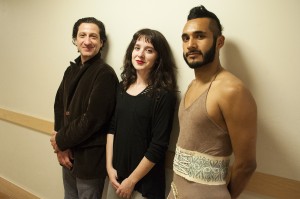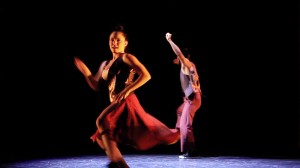Dorothy Dubrule, Julio Medina and Luis Tentindo came to UCLA’s Department of World Arts and Cultures/Dance a year and a half ago as master candidates. Over the past six months they have met every couple of weeks to offer each other advice on their pieces for the MFA2 dance show.
The three dance graduate students choreographed and will perform in this year’s MFA2 dance concert titled “What” on Friday in Glorya Kaufman Hall at 8 p.m.
The dance show is a platform for second-year world arts and cultures/dance graduate students with focuses on choreography and performance to present their work. As the only performer/choreographers in their year, the three students make up a cohort that provides feedback to one another throughout the creative process.
“Something really wonderful about being in this cohort is we are all from pretty different backgrounds – geographically, experientially and in terms of our interests,” Dubrule said. “It has been really wonderful to get (each other’s) feedback along the way.”

For their pieces, Dubrule said she explored contemporary dance with technology, while Medina said he drew on his family heritage and Tentindo said he explored the interaction between objects and the body.
Dubrule said she often collaborates with non-dancers and is interested in presenting contemporary dance to people who do not typically attend dance performances. For the MFA2 show, she combined dance with technology to create a piece of flexible genre that allows for improvisation.
Barry Brannum, a doctoral world arts and cultures/dance student, is performing alongside Dubrule and said it is important to find a balance between improvisation and the fulfillment of specific goals for the piece, while still accounting for the music.
“(Dubrule) has laid out the structure and within it we both have room to figure out different ways to fulfill each goal that we have,” Brannum said. “Every time we do it the movement is pretty different.”
Third-year Design | Media Arts student Samson Klitsner has managed the sound and technological aspects of Dubrule’s piece. He said he used Arduino, a technology that employs flex sensors to detect movement and trigger corresponding sounds that fit with the music and mood of the piece.

“Oftentimes the dance aspect of (the performance) is demonstrating the technology and doesn’t have an aesthetic integrity of its own,” Dubrule said. “It’s my hope (that the two elements can) each hold a place in the piece without undermining one another.”
Medina said he looked inward for the creation of his piece by drawing on his Mexican heritage and utilizing the dances he grew up with, as well as breakdancing, to explore gender roles, masculinity and power politics. He said his collaborator, fourth-year and fellow world arts and cultures/dance student Amanda Sanchez, looked to her personal life and Cuban heritage for similar inspiration.
“We looked at the way our parents treat each other, who wears the pants and different ways we can either break the norm or accentuate what’s already there,” Medina said. “It was very specific and personally investigative.”
Tentindo, who has a background in puppet theater and has often worked in groups, said he drew on his experience using objects on stage to create a solo piece that explores the relationship between performance states and small, handmade props.
“A big part of this experimentation is working by myself and seeing what I can do on my own and being able to travel lightly,” Tentindo said. “My interest has been around … finding a story through varying the relationships and states in relationship to these weird objects.”
Because each performance is independent, the students said the mood of the concert is specific to each individual piece and ranges from playful to uncomfortable to meditative. Despite the varying emotions the choreographers are expecting to evoke, all three said they aim to induce thoughtfulness and encourage new perspectives in the audience.
“They’re their own unique worlds,” Medina said. “I think that’s what’s so great about this show. You’re going to get a very diverse range of perspectives on different topics.”
Just as all three choreographers bring individual visions to the dances, Dubrule said they have similarly offered personalized insight to one another throughout the collaboration process.
“We all have very different relationships with dance as a discipline and working together for the last year and a half has really influenced one another in thinking about the potential for dance to be different things,” Dubrule said.
The students, who created a joint GoFundMe to raise money for the show, said these distinct outlooks supplemented their personal efforts and helped them over the past six months as they explored new aspects of dance for the creation of their pieces. They said they hope the audience is informed in a similar way after watching the performances.
“We hope that (the audience) feels engaged, inspired and that they’ve seen something that has caused them to perceive differently,” Dubrule said.
